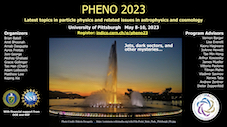Speaker
Description
The circular velocity curve, one of the first pieces of evidence for dark matter (DM), is a direct probe of the Galaxy’s potential, which allows studies of the nature of DM. Recent large surveys have provided valuable information for determining the Milky Way circular velocity curve. In this talk, I will describe our newly-derived circular velocity curve of the Milky Way out to ~30 kpc, which shows a sharp decline at R greater than 20 kpc. I will discuss the newly found best fit measurement of the virial mass, inner density profile, the local density, and the J-factor of the Galactic Center. We find that a cored Einasto profile with slope parameter 1.13 +/- 0.06 is a better fit to the data than a generalized or contracted Navarro-Frank-White (NFW), as was argued in previous studies. We also find the virial mass of the DM halo to be significantly lower than previous estimates, but the corresponding local DM density at the solar position is consistent with the literature. The cored profile may indicate baryonic effects such as starbursts after the central DM accretion has slowed down, or alternative DM models such as self-interacting DM. Future studies will focus on better modeling of the baryonic components and incorporating other dynamical probes such as the escape velocity. The studies will serve as a test for alternative DM models, such as self-interacting DM or dissipative models.

